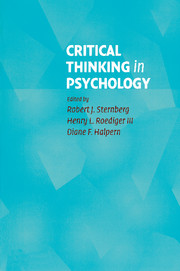Book contents
- Frontmatter
- Contents
- List of Illustrations and Tables
- List of Contributors
- Preface
- 1 The Nature and Nurture of Critical Thinking
- 2 Evaluating Experimental Research
- 3 Critical Thinking in Quasi-Experimentation
- 4 Evaluating Surveys and Questionnaires
- 5 Critical Thinking in Designing and Analyzing Research
- 6 The Case Study Perspective on Psychological Research
- 7 Informal Logical Fallacies
- 8 Designing Studies to Avoid Confounds
- 9 Evaluating Theories
- 10 Not All Experiments Are Created Equal
- 11 Making Claims in Papers and Talks
- 12 Critical Thinking in Clinical Inference
- 13 Evaluating Parapsychological Claims
- 14 Why Would Anyone Do or Believe Such a Thing?
- 15 The Belief Machine
- 16 Critical Thinking and Ethics in Psychology
- 17 Critical Thinking in Psychology
- Author Index
- Subject Index
- References
10 - Not All Experiments Are Created Equal
On Conducting and Reporting Persuasive Experiments
Published online by Cambridge University Press: 05 June 2012
- Frontmatter
- Contents
- List of Illustrations and Tables
- List of Contributors
- Preface
- 1 The Nature and Nurture of Critical Thinking
- 2 Evaluating Experimental Research
- 3 Critical Thinking in Quasi-Experimentation
- 4 Evaluating Surveys and Questionnaires
- 5 Critical Thinking in Designing and Analyzing Research
- 6 The Case Study Perspective on Psychological Research
- 7 Informal Logical Fallacies
- 8 Designing Studies to Avoid Confounds
- 9 Evaluating Theories
- 10 Not All Experiments Are Created Equal
- 11 Making Claims in Papers and Talks
- 12 Critical Thinking in Clinical Inference
- 13 Evaluating Parapsychological Claims
- 14 Why Would Anyone Do or Believe Such a Thing?
- 15 The Belief Machine
- 16 Critical Thinking and Ethics in Psychology
- 17 Critical Thinking in Psychology
- Author Index
- Subject Index
- References
Summary
If you leaf through a standard psychology textbook, it can reveal a wealth of insights into mind and behavior – into how people sense and perceive their environments, for instance, or how they learn, grow, remember, make decisions, or relate to each other. It can also reveal descriptions of the experiments that form an evidentiary basis for such insights. Each of these experiments demonstrates something noteworthy about how people think, feel, or act. Curiously though, if you leaf through a few competing textbooks, you will probably find the same experiments described repeatedly. This is curious because for many topics in psychology, numerous studies exist that demonstrate the same basic effect or reveal the same insight into behavior. Yet some experiments garner attention and citations whereas others that make the same points languish in relative obscurity. This happens, in part, because some experiments are more persuasive than others. That is, some experiments capture people's imaginations and attention more fully, offering especially compelling demonstrations of particular effects. These are the kinds of experiments that you, as a researcher, want to conduct and report. This chapter explores considerations that will, we hope, enable you to do so.
Unfortunately, there are no guarantees. There is no set formula to follow that can ensure that an experiment will be broadly persuasive. Every research problem is unique, with its own attendant issues and complexities.
- Type
- Chapter
- Information
- Critical Thinking in Psychology , pp. 160 - 176Publisher: Cambridge University PressPrint publication year: 2006
References
- 1
- Cited by

